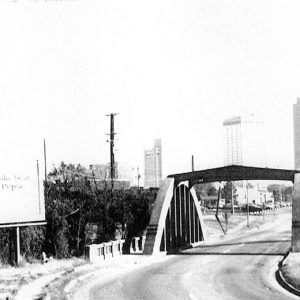calsfoundation@cals.org
Lincoln Avenue Viaduct
The Lincoln Avenue Viaduct is a single-span Rainbow Arch bridge constructed of reinforced concrete in 1928. It was listed on the National Register of Historic Places on April 9, 1990.
On April 21, 1927, the old Baring Cross Bridge between Little Rock (Pulaski County) and North Little Rock (Pulaski County), built in 1873 to carry rail traffic across the Arkansas River, was largely washed away by raging floodwaters despite the Missouri Pacific Railroad Company having weighed it down with coal cars. As the company worked to rebuild the crucial link to its sprawling rail yards in North Little Rock, it offered to build a new viaduct linking Lincoln Avenue and North Street above the railroad tracks on the Little Rock side of the river.
On May 16, 1928, Missouri Pacific officials announced that the viaduct would be made of “reinforced concrete structure of the latest bow string type” and would replace an existing Lincoln Avenue structure as well as a second decrepit viaduct on North Street while “a new street will be constructed to connect the west end of the new viaduct with North street,” the Arkansas Gazette reported. “The side slope of the new street on the track side will be protected by artistic rubble masonry walls.” The project was expected to cost $40,000. Little Rock’s city board approved the construction on May 29 with the stipulation that all of the cost would be borne by the railroad, though the structure would belong to the city.
By early July, construction crews were removing a rock bluff to allow space for the viaduct and for construction of a new Baring Cross Bridge, which was expected to cost $1 million. On August 24, 1928, the Gazette reported that “offices for the contractors for the Lincoln avenue viaduct of the Missouri Pacific Lines have been completed. Blasting for the viaduct has been done and construction work has begun.”
E. A. Hadley, the Missouri Pacific’s chief engineer, designed the Lincoln Avenue Viaduct, and the Ozark Engineering Company from Joplin, Missouri, built it under the direction of foreman Ray Bishop. The completed structure was “143 feet and 10 inches in length, overall,” the Arkansas Gazette reported. According to the National Register nomination, “The span across the tracks is 96 feet four inches, while there are 24-foot approaches at either end. It is provided with five-foot sidewalks on either side giving it a width of 50 feet six inches. The roadway is 30 foot wide while the arch rings extend 21 feet over and above the roadway.” The arches consisted of steel frames “covered with concrete to create continuity between the different structural parts.”
The Lincoln Avenue Viaduct was dedicated on December 28, 1928, with the Missouri Pacific Railroad’s chief of public improvements giving brief remarks, after which two cars holding members of the Little Rock City Council’s Street Committee drove across the structure. The Gazette reported that “the new viaduct on Lincoln avenue across the tracks of the Missouri Pacific Line, one of the most beautiful structures of its kind in the country, was opened at 2:05 p.m.”
The structure, located just east of the McDonald-Wait-Newton House on today’s Cantrell Road, still bears westbound traffic in the twenty-first century. The balustrade on its south side was later removed so a second bridge could be constructed, incorporating the original sidewalk, but the Lincoln Avenue Viaduct still exhibits its distinctive rainbow arches.
For additional information:
“City Authorizes Railway Viaduct.” Arkansas Gazette, May 29, 1928, p. 8.
“Missouri Pacific Viaduct Is Opened.” Arkansas Gazette, December 29, 1928, p. 12.
O’Reilly, Sean, and Corinne Smith. “Lincoln Avenue Viaduct.” National Register of Historic Places registration form. On file at Arkansas Historic Preservation Program, Little Rock, Arkansas. Online at http://www.arkansaspreservation.com/National-Register-Listings/PDF/PU2025.nr.pdf (accessed December 11, 2020).
“Railroad Announces Plans for Viaduct.” Arkansas Gazette, May 16, 1928, p. 14.
“Viaduct Work to Begin by August 1.” Arkansas Gazette, July 6, 1928, p. 12.
Mark K. Christ
Central Arkansas Library System



 Lincoln Avenue Viaduct
Lincoln Avenue Viaduct  Lincoln Avenue Viaduct
Lincoln Avenue Viaduct 



Comments
No comments on this entry yet.